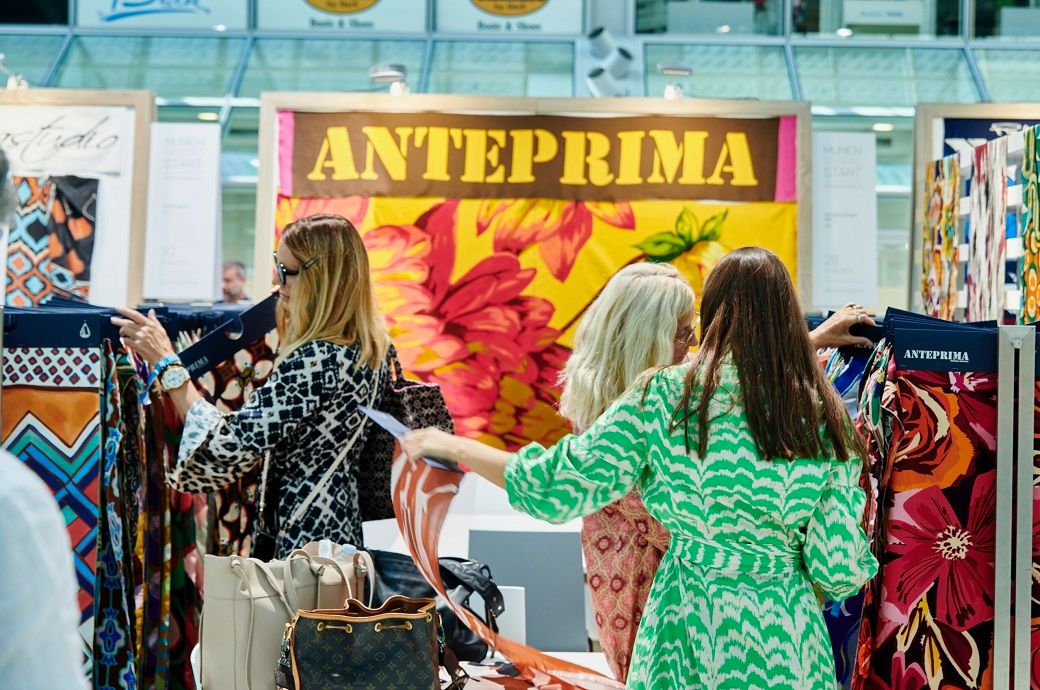
Munich Fabric Start was held from August 30 to September 1, 2022. The fair’s exhibition area was around 2,500 square metres more than at the last pre-COVID edition in September 2019, the organisers said in a press release.
Within the general trend in the trade show and event sector, Munich Fabric Start also recorded a corresponding decline in the number of visitors compared to pre-COVID times. With 14,200 visitors, the number was down, which was to be expected considering the continuing travel restrictions and reservations, especially transcontinental, as well as the structural changes to be observed in the fashion industry. Nevertheless, the quality of the buyers, designers, and product managers present was found satisfactory by the exhibitors.
Mostly companies from Germany, Austria, and Switzerland came to Munich, including Adidas, ArmedAngels, Baldessarini, BMW, C&A, Cinque, Comma, Drykorn, Ecoalf, Hallhuber, the Holy Fashion Group, Hugo Boss, Lagerfeld, Laurèl, Mac, Marc Cain, Marc O‘Polo, Nike, Peek & Cloppenburg, Riani, S Oliver, Schumacher, Strellson, Vaude, Windsor, or Zalando. The Netherlands remained an important visitor group with companies such as Calvin Klein, Claudia Sträter, Expresso Fashion, and Scotch & Soda. Also strongly represented with their teams were the Scandinavian region with visitors such as Selected/Homme and the Bestseller Group as well as brands from France and Italy, including Calzedonia, Diesel, Giorgio Armani, or Lacoste.
At both Munich Fabric Start in the MOC and Bluezone, the organisers further expanded their successful show-in-show concept. In the light-flooded Atrium 3 of Design Studios, 60 leading international fabric designers as well as print and pattern developers came together. Keyhouse and Catalyser brought together technological, sustainable, and aesthetic innovation drivers at the intersection of fashion and denim. The completely new format, The Source, was fully booked at its premiere with around 65 exhibitors and provided answers to the increasing demand for manufacturing and nearshoring in the newly opened Hall 8 directly opposite the MOC.
In Germany, Europe’s most price-sensitive market, almost every discussion at the show was about finding approaches to maintaining price points on the one hand and not sacrificing quality on the other — a balancing act in times of rising energy prices. “In fact, I have to say that our discussions are not so much about trends and innovation — even though we receive a lot of encouragement there, of course. The main topic is the price. This is also reflected in the fact that customers are increasing their direct cooperation with us suppliers. They gratefully take advantage of any support and look to us for one thing above all: solutions to current challenges,” said Barbara Hoechel, managing director, Balli.
Conversely, the desire for new things is greater than it has been for a long time. “Our task as a leading denim player is to think ahead. Our customers are currently more willing than ever to try out new things,” said Holger Heitland, key account manager, Isko, who showed again at Bluezone after six years. “We are back at Bluezone for the first time in six years and we are overwhelmed. From high-end to volume market — everyone was there — the important main customers as well as new customers. We are super happy.”
Visitors encountered innovations in all areas of Munich Fabric Start and across all steps of the value chain. Many innovative raw materials were on show that are either recycled, recyclable, or biodegradable, for example from Wastea, Pinatex, and Incalpaca. Processes are also becoming more innovative. The many examples of highly efficient innovations to be discovered ranged from waterless dyeing to oxygen-based finishing to AI-driven processes — as seen at Muze, Wiser, and Tejidos Royos. In addition, fully digital dressing and design options played an increasingly important role. “The physical and digital worlds are increasingly merging, also in the fashion sector. The virtual space is unleashing unimagined power. We truly believe that the digital future is limitless,” commented Sedef Uncu Aki, managing director of Orta, on the perspectives opening up in the virtual space.
One topic at almost every stand was sustainability. “We had two super days. We had 55 customers at the stand, 40 of them good existing customers from Hugo Boss to Walbusch to Trachten. Clearly, everything to do with sustainability is in demand. Now even those who have always laughed about the topic are coming,” confirmed Gerhard Leitner, managing director, Getzner Textil.
In the dedicated presentation area Sustainable Innovations, curated by Simon Angel, visitors were able to discover six particularly thought-provoking and inspiring innovations in Keyhouse: From Biotic — fabrics grown from micro-organisms — by Studio Lionne van Deursen to a leather alternative made from flower waste by the project Flower Matter by Irene Purasachit and wearable muscles by Soft-Robotics. In addition, the Lecture Centre of the Trend Seminars attracted many listeners to Keyhouse.
The panel discussion on ‘Energy, the silent but huge raw material and key resource in denim’ with Alberto Candiani, president of Candiani Denim; Talha Khan, executive director of the Pakistan Environmental Trust; Johannes Stefan, commercial director Europe, Americas, Turkey/ Africa/CIS at Lenzing Group; and Yucel Bayram, sales & marketing director Kipas Holding. The talk, which was moderated by Transformers Foundation founder Andrew Olah, attracted special attention, added the release.
“We’re looking at energy as just another raw material, just like water, just like cotton. Therefore, I believe in efficiency as the grandfather of sustainability. In the end we’re surviving because of innovation,” said Alberto Candiani, president of Candiani Denim.
“Like most industries, the textile industry, and the denim industry in particular, is not immune to problems arising from gas shortages and skyrocketing energy prices. For innovative companies, this is less of a problem — and in some cases, earlier decisions for more energy-efficient and sustainable technologies are currently paying off. Chemical-free and virtually waterless refining technology is becoming increasingly lucrative,” emphasised Jesper Andersen from Wiser.
Fibre2Fashion News Desk (NB)